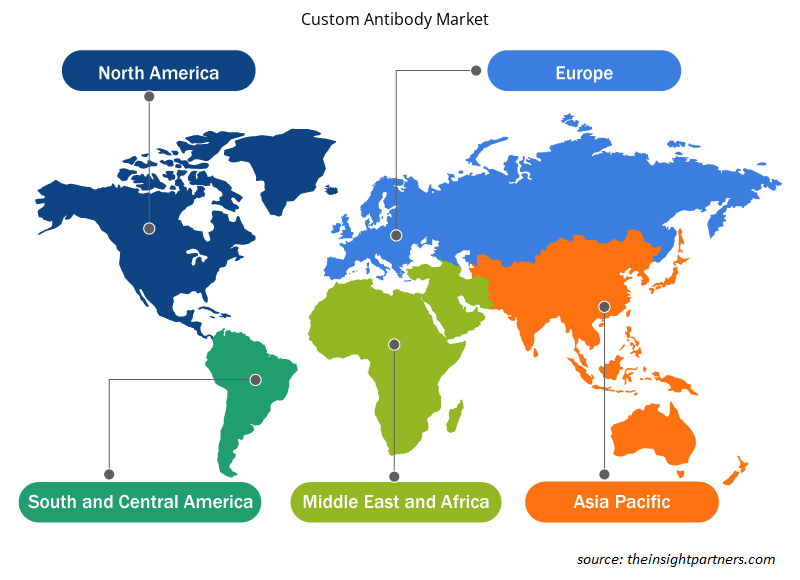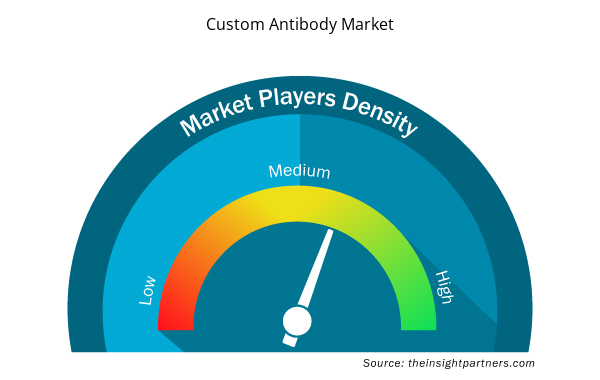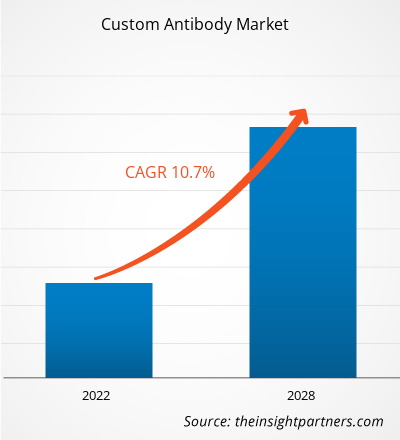Der Markt für kundenspezifische Antikörper wurde von 409,26 Millionen US-Dollar im Jahr 2021 auf 833,71 Millionen US-Dollar im Jahr 2028 geschätzt; es wird geschätzt, dass er von 2021 bis 2028 mit einer durchschnittlichen jährlichen Wachstumsrate von 10,7 % wächst.
In Mäusen, Ratten oder Hamstern können maßgeschneiderte Antikörper erzeugt werden, um alle Wirtsanforderungen zu erfüllen. Unternehmen bieten eine breite Palette von Antikörpern entsprechend den Anforderungen des Forschers an. Auf dem Markt gibt es eine Vielzahl maßgeschneiderter Antikörper, darunter polyklonale und monoklonale Antikörper, rekombinante monoklonale Antikörper, Hybridom-Antikörper, polyklonale rekombinante Antikörper und andere. Unternehmen bieten umfassende Unterstützungsdienste für alle Arten und Schritte der Antikörperproduktion an, von Peptiddesign, Synthese und Trägerproteinkonjugation bis hin zur Tierimmunisierung, Serumsammlung oder Hybridomfusion, Titeranalyse und endgültigen Antikörperreinigung.
Das Wachstum des Marktes für kundenspezifische Antikörper wird auf Faktoren wie den hohen Forschungsbedarf, die wachsende Unterstützung durch Regierungen, sich ständig ändernde Krankheitsprofile, zunehmende öffentlich-private Partnerschaften und zunehmende Finanzierungsaktivitäten zurückgeführt, die die Leistung der Biotechnologie erheblich steigern. Die Produktion der monoklonalen und polyklonalen Antikörper variiert jedoch je nach den Tieren, aus denen sie gewonnen werden. Die Kosten werden auch durch die Pakete kundenspezifischer Antikörper bestimmt, die für verschiedene Anwendungen benötigt werden und von verschiedenen Akteuren angeboten werden, was das Marktwachstum behindert.
Passen Sie diesen Bericht Ihren Anforderungen an
Sie erhalten kostenlose Anpassungen an jedem Bericht, einschließlich Teilen dieses Berichts oder einer Analyse auf Länderebene, eines Excel-Datenpakets sowie tolle Angebote und Rabatte für Start-ups und Universitäten.
- Holen Sie sich die wichtigsten Markttrends aus diesem Bericht.Dieses KOSTENLOSE Beispiel umfasst eine Datenanalyse von Markttrends bis hin zu Schätzungen und Prognosen.
Markteinblicke
Von Anbietern kundenspezifischer Antikörper angebotene Produktions- und Entwicklungsdienstleistungen
Verschiedene Unternehmen bieten intensiv Forschungs- und Entwicklungsdienstleistungen für kundenspezifische Antikörper an. Nachfolgend sind einige der von diesen Unternehmen eingeführten Dienstleistungen aufgeführt.
- Im Juni 2021 kündigte GenScript die Einführung von MonoRab an, einem maßgeschneiderten Service für monoklonale Kaninchen-Antikörper (mAB). Es wird in das integrierte Premium-Antikörper-Serviceportfolio des Unternehmens aufgenommen. MonoRab ist die proprietäre Technologie des Unternehmens, die die Kombination von Hybridomtechnologien und monoklonaler Antikörpersequenzierung im Frühstadium nutzt. Beide Technologien liefern maßgeschneiderte Kaninchen-mAbs, die spezifischer sind und eine höhere Affinität sowie vielfältige Fähigkeiten besitzen, die für ein breites Anwendungsspektrum erforderlich sind.
- Im März 2021 startete Giotto Biotech spezialisierte Produktionsdienstleistungen für polyklonale und monoklonale Antikörper. Das Unternehmen ermöglicht die Produktion von mehr als 500 monoklonalen Antikörpertypen, die für diagnostische und therapeutische Anwendungen eingesetzt werden können. Es bietet eine große Auswahl an Arten als Quellen für polyklonale Antikörper.
- Im November 2020 kündigte AMSBIO Entwicklungsdienste für rekombinante monoklonale Antikörper von Kaninchen und Mäusen an. Die Entwicklung rekombinanter monoklonaler Antikörper basiert auf der DimAb-Entwicklungsplattform, die sich von herkömmlichen Hybridomfusionstechnologien unterscheidet. Sie ist in der Lage, IgG-Gene aus B-Zellen immunisierter Tiere zu isolieren. Diese Antikörper helfen bei der Entwicklung und Vermarktung von Medikamenten auf dem Markt. Im Oktober 2019 genehmigte die FDA das erste aus monoklonalen Kaninchen-Antikörpern gewonnene Medikament – Beovu. Beovu ist zur Behandlung der feuchten altersbedingten Makuladegeneration (AMD) vorgesehen.
- Im März 2020 kündigte Absolute Antibody Ltd. die Einführung eines Hochdurchsatz-Produktionsdienstes für rekombinante Antikörper für seinen FleXpress an. Das Unternehmen bietet seinen Kunden Dienstleistungen zur Erleichterung der schnellen Expression vieler Antikörper bis zu einem Volumen von 80 ml sowie zur Steigerung der Produktionskapazität, um der steigenden Nachfrage nach rekombinanter Antikörpertechnologie gerecht zu werden.
Solche von Unternehmen angebotenen kundenspezifischen Dienstleistungen zur Antikörperproduktion beschleunigen das Marktwachstum.
Servicebasierte Einblicke
Basierend auf dem Service ist der Markt für kundenspezifische Antikörper in Antikörperentwicklung, Antikörperproduktion und -reinigung sowie Antikörperfragmentierung und -markierung segmentiert. Im Jahr 2020 hatte das Segment Antikörperentwicklung den größten Marktanteil und wird im Prognosezeitraum voraussichtlich mit einer signifikanten durchschnittlichen jährlichen Wachstumsrate wachsen.
Typbasierte Erkenntnisse
Basierend auf dem Typ ist der Markt für kundenspezifische Antikörper in monoklonale Antikörper, polyklonale Antikörper und andere kundenspezifische Antikörper unterteilt. Im Jahr 2020 hielt das Segment der monoklonalen Antikörper den größten Marktanteil, während das Segment der polyklonalen Antikörper im Prognosezeitraum voraussichtlich wachsen wird.
Quellenbasierte Erkenntnisse
Basierend auf der Quelle ist der Markt für kundenspezifische Antikörper in Mäuse, Kaninchen und andere unterteilt. Das Mäusesegment hatte im Jahr 2020 den größten Marktanteil, während das Mäusesegment im Prognosezeitraum voraussichtlich die höchste durchschnittliche jährliche Wachstumsrate auf dem Markt verzeichnen wird.
Forschungsbereichsbasierte Erkenntnisse
Basierend auf dem Forschungsbereich ist der Markt für kundenspezifische Antikörper in Onkologie, Immunologie, Stammzellen, Infektionskrankheiten, Neurobiologie, Herz-Kreislauf-Erkrankungen und andere unterteilt. Das Onkologiesegment hielt im Jahr 2020 den größten Marktanteil, während das Stammzellensegment im Prognosezeitraum voraussichtlich die höchste durchschnittliche jährliche Wachstumsrate auf dem Markt verzeichnen wird.
Endbenutzerbasierte Erkenntnisse
Basierend auf den Endverbrauchern ist der Markt für kundenspezifische Antikörper in Pharma- und Biotechnologieunternehmen, akademische und Forschungsinstitute sowie Auftragsforschungsinstitute unterteilt. Im Jahr 2020 hielt das Segment der Pharma- und Biotechnologieunternehmen den größten Marktanteil und wird in den kommenden Jahren voraussichtlich am schnellsten wachsen.
Produkteinführungen und Zulassungen sind die von Unternehmen am häufigsten angewandten Strategien, um ihre globale Präsenz und ihr Produktportfolio zu erweitern. Darüber hinaus konzentrieren sich die Akteure auf dem Markt für Brustrekonstruktionen auf die Kooperationsstrategie, um ihren Kundenstamm zu vergrößern, was ihnen wiederum ermöglicht, ihren Markennamen weltweit aufrechtzuerhalten.
Regionale Einblicke in den Markt für kundenspezifische Antikörper
Die regionalen Trends und Faktoren, die den Markt für kundenspezifische Antikörper während des gesamten Prognosezeitraums beeinflussen, wurden von den Analysten von Insight Partners ausführlich erläutert. In diesem Abschnitt werden auch Marktsegmente und Geografien für kundenspezifische Antikörper in Nordamerika, Europa, im asiatisch-pazifischen Raum, im Nahen Osten und Afrika sowie in Süd- und Mittelamerika erörtert.

- Erhalten Sie regionalspezifische Daten zum Markt für kundenspezifische Antikörper
Umfang des Marktberichts zu kundenspezifischen Antikörpern
| Berichtsattribut | Details |
|---|---|
| Marktgröße im Jahr 2021 | 409,26 Millionen US-Dollar |
| Marktgröße bis 2028 | 833,71 Millionen US-Dollar |
| Globale CAGR (2021 - 2028) | 10,7 % |
| Historische Daten | 2019-2020 |
| Prognosezeitraum | 2022–2028 |
| Abgedeckte Segmente | Nach Service
|
| Abgedeckte Regionen und Länder | Nordamerika
|
| Marktführer und wichtige Unternehmensprofile |
|
Dichte der Marktteilnehmer für kundenspezifische Antikörper: Die Auswirkungen auf die Geschäftsdynamik verstehen
Der Markt für kundenspezifische Antikörper wächst rasant. Dies wird durch die steigende Nachfrage der Endnutzer aufgrund von Faktoren wie sich entwickelnden Verbraucherpräferenzen, technologischen Fortschritten und einem größeren Bewusstsein für die Vorteile des Produkts vorangetrieben. Mit der steigenden Nachfrage erweitern Unternehmen ihr Angebot, entwickeln Innovationen, um die Bedürfnisse der Verbraucher zu erfüllen, und nutzen neue Trends, was das Marktwachstum weiter ankurbelt.
Die Marktteilnehmerdichte bezieht sich auf die Verteilung der Firmen oder Unternehmen, die in einem bestimmten Markt oder einer bestimmten Branche tätig sind. Sie gibt an, wie viele Wettbewerber (Marktteilnehmer) in einem bestimmten Marktraum im Verhältnis zu seiner Größe oder seinem gesamten Marktwert präsent sind.
Die wichtigsten auf dem Markt für kundenspezifische Antikörper tätigen Unternehmen sind:
- Thermo Fisher Scientific Inc
- Bio-Rad Laboratories Inc
- Merck KGaA
- ABCAM
- GenScript
Haftungsausschluss : Die oben aufgeführten Unternehmen sind nicht in einer bestimmten Reihenfolge aufgeführt.

- Überblick über die wichtigsten Akteure auf dem Markt für kundenspezifische Antikörper
Nach Service
- Antikörperentwicklung
- Antikörperproduktion und -reinigung
- Antikörperfragmentierung und Markierung
Nach Typ
- Monoklonale Antikörper
- Polyklonale Antikörper
- Andere kundenspezifische Antikörper
Nach Quelle
- Mäuse
- Kaninchen
- Sonstiges
Nach Forschungsbereich
- Onkologie
- Immunologie
- Stammzellen
- Infektionskrankheiten
- Neurobiologie
- Herz-Kreislauf-Erkrankungen
- Sonstiges
Von Endbenutzern
- Pharma- und Biotechnologieunternehmen
- Akademische und Forschungsinstitute
- Auftragsforschungsinstitute
Nach Geografie
- Nordamerika
- UNS
- Kanada
- Mexiko
- Europa
- Frankreich
- Deutschland
- Italien
- Vereinigtes Königreich
- Spanien
- Restliches Europa
- Asien-Pazifik (APAC)
- China
- Indien
- Südkorea
- Japan
- Australien
- Restlicher Asien-Pazifik-Raum
- Naher Osten und Afrika (MEA)
- Südafrika
- Saudi-Arabien
- Vereinigte Arabische Emirate
- Restlicher Naher Osten und Afrika
- Süd- und Mittelamerika (SCAM)
- Brasilien
- Argentinien
- Restliches Süd- und Mittelamerika
Firmenprofile
- Thermo Fisher Scientific Inc
- Bio-Rad Laboratories Inc
- Merck KGaA
- ABCAM
- GenScript
- Rockland Immunochemicals, Inc
- ProMab
- BioLegend, Inc
- Agilent Technologies, Inc
- Cell Signaling Technology, Inc
- Historische Analyse (2 Jahre), Basisjahr, Prognose (7 Jahre) mit CAGR
- PEST- und SWOT-Analyse
- Marktgröße Wert/Volumen – Global, Regional, Land
- Branche und Wettbewerbsumfeld
- Excel-Datensatz



Report Coverage
Revenue forecast, Company Analysis, Industry landscape, Growth factors, and Trends

Segment Covered
This text is related
to segments covered.

Regional Scope
North America, Europe, Asia Pacific, Middle East & Africa, South & Central America

Country Scope
This text is related
to country scope.
Häufig gestellte Fragen
The growth of the region is attributed to factors such as rising public–private partnerships, and increasing funding activities are widely enhancing the performance of biotechnology Moreover, presence of well-developed healthcare infrastructure and government support are some of the prominent factors propelling the market growth in Asia Pacific. In addition, the Europe is expected account for the fastest growth in the custom antibody market. A high demand in research, growing support from governments, continuously changing disease profiles, rising public–private partnerships, and increasing funding activities are widely enhancing the performance of biotechnology growth of Europe custom antibody market during the forecast period.
Customized antibodies can be generated in a mouse, rat or hamster, to meet any particular host requirements. Companies are providing wide range of antibodies according to the researcher's requirements. There are variety of customized antibodies in the market which includes polyclonal and monoclonal antibody, recombinant monoclonal antibody, hybridoma antibody, polyclonal recombinant antibody and others. Companies are offering complete support services for all types and steps of antibody production from peptide design, synthesis, and carrier protein conjugation to animal immunization, serum collection, or hybridoma fusion, titer analysis, and final antibody purification.
The growth of the market is attributed to some key driving factors such as the high demand in research, growing support from governments, continuously changing disease profiles, rising public–private partnerships, and increasing funding activities are widely enhancing the performance of biotechnology. For instance, In January 2021, Morphic Therapeutic, a biotechnology company, collaborated with Janssen Pharmaceutical, Inc., a part of Johnson & Johnson Private Limited, to develop novel antibodies against third integrin target proteins (a family of ubiquitous receptors. Such strategic steps are also projected to drive the market growth.
Trends and growth analysis reports related to Life Sciences : READ MORE..
The List of Companies - Custom Antibody Market
- Thermo Fisher Scientific Inc
- Bio-Rad Laboratories Inc
- Merck KGaA
- ABCAM
- GenScript
- Rockland Immunochemicals, Inc
- ProMab
- BioLegend, Inc
- Agilent Technologies, Inc
- Cell Signaling Technology, Inc
The Insight Partners performs research in 4 major stages: Data Collection & Secondary Research, Primary Research, Data Analysis and Data Triangulation & Final Review.
- Data Collection and Secondary Research:
As a market research and consulting firm operating from a decade, we have published and advised several client across the globe. First step for any study will start with an assessment of currently available data and insights from existing reports. Further, historical and current market information is collected from Investor Presentations, Annual Reports, SEC Filings, etc., and other information related to company’s performance and market positioning are gathered from Paid Databases (Factiva, Hoovers, and Reuters) and various other publications available in public domain.
Several associations trade associates, technical forums, institutes, societies and organization are accessed to gain technical as well as market related insights through their publications such as research papers, blogs and press releases related to the studies are referred to get cues about the market. Further, white papers, journals, magazines, and other news articles published in last 3 years are scrutinized and analyzed to understand the current market trends.
- Primary Research:
The primarily interview analysis comprise of data obtained from industry participants interview and answers to survey questions gathered by in-house primary team.
For primary research, interviews are conducted with industry experts/CEOs/Marketing Managers/VPs/Subject Matter Experts from both demand and supply side to get a 360-degree view of the market. The primary team conducts several interviews based on the complexity of the markets to understand the various market trends and dynamics which makes research more credible and precise.
A typical research interview fulfils the following functions:
- Provides first-hand information on the market size, market trends, growth trends, competitive landscape, and outlook
- Validates and strengthens in-house secondary research findings
- Develops the analysis team’s expertise and market understanding
Primary research involves email interactions and telephone interviews for each market, category, segment, and sub-segment across geographies. The participants who typically take part in such a process include, but are not limited to:
- Industry participants: VPs, business development managers, market intelligence managers and national sales managers
- Outside experts: Valuation experts, research analysts and key opinion leaders specializing in the electronics and semiconductor industry.
Below is the breakup of our primary respondents by company, designation, and region:

Once we receive the confirmation from primary research sources or primary respondents, we finalize the base year market estimation and forecast the data as per the macroeconomic and microeconomic factors assessed during data collection.
- Data Analysis:
Once data is validated through both secondary as well as primary respondents, we finalize the market estimations by hypothesis formulation and factor analysis at regional and country level.
- Macro-Economic Factor Analysis:
We analyse macroeconomic indicators such the gross domestic product (GDP), increase in the demand for goods and services across industries, technological advancement, regional economic growth, governmental policies, the influence of COVID-19, PEST analysis, and other aspects. This analysis aids in setting benchmarks for various nations/regions and approximating market splits. Additionally, the general trend of the aforementioned components aid in determining the market's development possibilities.
- Country Level Data:
Various factors that are especially aligned to the country are taken into account to determine the market size for a certain area and country, including the presence of vendors, such as headquarters and offices, the country's GDP, demand patterns, and industry growth. To comprehend the market dynamics for the nation, a number of growth variables, inhibitors, application areas, and current market trends are researched. The aforementioned elements aid in determining the country's overall market's growth potential.
- Company Profile:
The “Table of Contents” is formulated by listing and analyzing more than 25 - 30 companies operating in the market ecosystem across geographies. However, we profile only 10 companies as a standard practice in our syndicate reports. These 10 companies comprise leading, emerging, and regional players. Nonetheless, our analysis is not restricted to the 10 listed companies, we also analyze other companies present in the market to develop a holistic view and understand the prevailing trends. The “Company Profiles” section in the report covers key facts, business description, products & services, financial information, SWOT analysis, and key developments. The financial information presented is extracted from the annual reports and official documents of the publicly listed companies. Upon collecting the information for the sections of respective companies, we verify them via various primary sources and then compile the data in respective company profiles. The company level information helps us in deriving the base number as well as in forecasting the market size.
- Developing Base Number:
Aggregation of sales statistics (2020-2022) and macro-economic factor, and other secondary and primary research insights are utilized to arrive at base number and related market shares for 2022. The data gaps are identified in this step and relevant market data is analyzed, collected from paid primary interviews or databases. On finalizing the base year market size, forecasts are developed on the basis of macro-economic, industry and market growth factors and company level analysis.
- Data Triangulation and Final Review:
The market findings and base year market size calculations are validated from supply as well as demand side. Demand side validations are based on macro-economic factor analysis and benchmarks for respective regions and countries. In case of supply side validations, revenues of major companies are estimated (in case not available) based on industry benchmark, approximate number of employees, product portfolio, and primary interviews revenues are gathered. Further revenue from target product/service segment is assessed to avoid overshooting of market statistics. In case of heavy deviations between supply and demand side values, all thes steps are repeated to achieve synchronization.
We follow an iterative model, wherein we share our research findings with Subject Matter Experts (SME’s) and Key Opinion Leaders (KOLs) until consensus view of the market is not formulated – this model negates any drastic deviation in the opinions of experts. Only validated and universally acceptable research findings are quoted in our reports.
We have important check points that we use to validate our research findings – which we call – data triangulation, where we validate the information, we generate from secondary sources with primary interviews and then we re-validate with our internal data bases and Subject matter experts. This comprehensive model enables us to deliver high quality, reliable data in shortest possible time.


 Holen Sie sich ein kostenloses Muster für diesen Bericht
Holen Sie sich ein kostenloses Muster für diesen Bericht